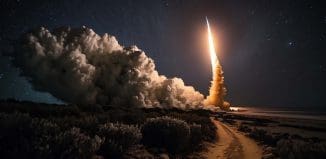Space Surveillance System – Equipped With World Fastest Camera
This post is also available in:  עברית (Hebrew)
עברית (Hebrew)
The US Defense Advanced Research Projects Agency (DARPA) officially handed off control of the Space Surveillance Telescope (SST) to the US Air Force Space Command. After five years of successful operation the telescope will now be dismantled and sent overseas.
Australian forces are planned to handle the task of scanning the skies for asteroids that could endanger satellites or potentially strike the Earth. The Air Force will maintain “a broad and full SST partnership” with the Australian military, said 1st Lt. Sarah Burnett, a spokeswoman for Air Force Space Command (AFSPC). After the move, SST will operate as a dedicated sensor in the US Space Surveillance Network, operated by AFSPC.
“Space is congested with tens of thousands of manmade objects, micro-meteors, asteroids and other natural satellites. In order to address these threats, the Australians are building the facility to house the telescope. AFSPC will relocate the telescope and share continuing agreed-upon maintenance 50-50 for the life of the system,” she said.
According to c4isrnet.com, SST has played a key role in defending against such hazards since it began it’s service in 2011. The telescope logged 2.2 million asteroid observations in 2014 and 7.2 million in 2015, with the 2016 total expected to reach 10 million. That makes it the world’s most prolific tool for asteroid observation. The telescope, located at White Sands Missile Range in New Mexico, also has discovered 3,600 new asteroids and 69 near-Earth objects, including four that show some risk of impacting Earth, DARPA says.
Of course, the ability to detect threats in space is not the same as the ability to defend against them. Asked whether the telescope will improve the military’s defensive posture in space, AFSPC referred to recent public comments by Gen. John Hyten, head of US Strategic Command. “We’re developing capabilities to defend ourselves,” he said. “It’s really that simple.”
Program leaders say SST is the product of intensive scientific work between DARPA and the MIT Lincoln Laboratory, a federally funded R&D facility whose scientists apply advanced technology to problems of national security.
The camera itself boasts what the Air Force calls the world’s fastest telescope camera shutter, able to take thousands of pictures each night. Program managers also have made recent upgrades to the faint-object detection algorithms.
Now that AFSPC has taken charge of SST, the Air Force plans to spend the next several months dismantling it in preparation for its intercontinental relocation, a move that will help the service to bridge a gap in coverage in the Southern Hemisphere.
“In early 2017, SST will be disassembled in New Mexico and shipped to Australia. Once SST is reassembled and reaches initial operational capability, our space analysts will examine the data and investigate new ways to exploit the SST data,” Burnett said. “SST will be operated in a wide area search mode to track known objects and detect new objects.”
AFSPC expects to see a large number of small objects added to present known inventory once SST is up and running, she said.
Managers expect the telescope to be reassembled, calibrated, and ready for initial operational capability in 2020. Beyond that, “SST will be improved as technology and funding allow,” Burnett said. “We are constantly looking for ways to improve the capabilities we deliver to the warfighter to make timely decisions.”





























